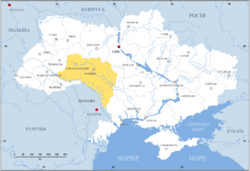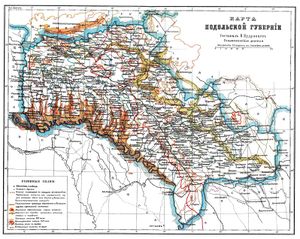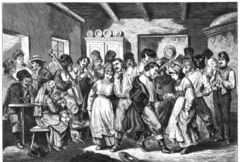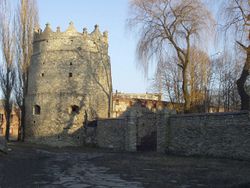پودوليا
پودوليا
Поділля, Podolia Podolia, Podilia | |
|---|---|
| |
 پودوليا (أصفر) في أوكرانيا الحديثة | |
| البلدان | أوكرانيا، مولدوڤا |
| المنطقة | غرب أوكرانيا، وسط أوكرانيا |
| عاصمة تاريخية | كاميانتس-پوديلسكي |
| أكبر مدينة | ڤينيتسا |
| المناطق | أوبلاست ترنوپيل، أبلاست خملنيتسكي، أوبلاست ڤينيتسيا، أوبلاست أوديسا، أوبلاست تشركاسي |
| منطقة التوقيت | UTC+2 (EET) |
| • الصيف (التوقيت الصيفي) | UTC+3 (EEST) |
پودوليا Podolia أو پوديليا (أوكرانية: Поділля, romanized: Podillia، IPA: [poˈd⁽ʲ⁾ilʲːɐ]؛ روسية: Подолье, romanized: Podolye؛ رومانية: Podolia؛ پولندية: Podole؛ ألمانية: Podolien؛ بالبيلاروسية: Падолле؛ لتوانية: Podolė؛ باليديشية: פאדאליע)، هي منطقة تاريخية في شرق أوروپا، تقع في الغرب الأوسط والجنوب الغربي لما هو اليوم أوكرانيا وفي شمال شرق مولدوڤا (أي شمال ترانسنيستريا). الاسم مشتق من السلاڤية القديمة پو po، وتعني "بجانب أو بحذى"، و دول dol، "وادي" (انظر وادي مفتوح).
الجغرافيا
تقع پودوليا جنوب ڤولهينيا، وجنوب غرب أوبلاس كييڤ، وشمال شرق نهر دنيستر، وشرق گاليسيا (أوروپا) عبر نهر زبروتش، أحد روافد نهر دنيستر.
تبلغ مساحتها حوالي 40.000 كيلومتر مربع، وتمتد لمسافة 320 كيلومترًا من الشمال الغربي إلى الجنوب الشرقي على الضفة اليسرى لنهر دنيستر. وفي نفس الاتجاه، تمتد سلسلتان من التلال المنخفضة نسبيًا، تفصل بينهما سلسلة جبال بوگ الجنوبية، وهي امتدادات لمرتفعات أڤراتينسك.

يتدفق من المنطقة نهران كبيران لهما العديد من الروافد: نهر دنيستر الذي يشكل حدودها مع مولدوڤا ويمكن الملاحة على امتداد النهر، ونهر بوگ الجنوبي الذي يتدفق بشكل موازٍ تقريبًا للنهر الأول في وادٍ علوي، مليء بالمستنقعات في بعض الأحيان، تتخلله المنحدرات في عدة أماكن. يشكل نهر دنيستر قناة هامة للتجارة في منطقتي موهيليڤ-پوديلسكي وژڤانتس وموانئ نهرية أخرى في پودوليا.
في پودوليا، تسود تربة "سوداء" (الأرض السوداء)، مما يجعلها منطقة زراعية خصبة للغاية. وتوجد المستنقعات فقط بجانب نهر بوگ. ويسود مناخ معتدل، حيث يبلغ متوسط درجات الحرارة في كاميانتس-پوديلسكي 9 درجات مئوية (-4 درجات مئوية في يناير، و20 درجة مئوية في يوليو).
عام 1906، كان عدد سكان پودوليا الخاضعة للحكم الروسي 3.543.700 نسمة، وكان أغلبهم من الأوكرانيين. وكانت هناك أقليات كبيرة من الپولنديين واليهود، بالإضافة إلى 50.000 من الرومانيين، وبعض الألمان، وقليل من الأرمن.[بحاجة لمصدر]
البلدات الرئيسية تضم كاميانتس-پوديلسكي، العاصمة التقليدية بالتا، براتسلاڤ، هايسين، لتيتشيڤ، موهيليڤ-پوديلسكي، نوڤا أوسهيتسيا، أولهوپيل، خملنيتسكي، ڤينيتسا، يامپيل. في مولدوڤا، المدن الپودولية الرئيسية هي كامنكا وريبنتيا،
تشتهر پودوليا بالكرز، توت العليق، الشمام، القرع، والخيار
التاريخ

كانت المنطقة مأهولة بالسكان منذ بداية العصر الحجري الحديث على الأقل. يذكرها هيرودوت بأنها كانت مقرًا للهاليزون اليونانيين-السكوذيين وربما النيوري السكوذيين. بعد ذلك، وصل الداشيون والگتاي. ترك الرومان آثارًا لحكمهم في سور تراجان، الذي يمتد عبر المناطق الحديثة في كاميانتس-پوديلسكي ونوڤا أوشيتسيا وخملنيتسكي.
خلال عصر الهجرات الكبرى، مرت العديد من القوميات عبر هذه المنطقة أو استقرت فيها لبعض الوقت، تاركة آثارًا عديدة. يذكر نستور في السجل التاريخي الأساسي أربع قبائل سلاڤية أبرزها: البوژانيون والدولبس على امتداد نهر بوگ الجنوبي، والتيڤرتسي والأوليتش على امتداد نهر دنيستر. غزا آڤار پانونيا المنطقة في القرن السابع.
روس الكييڤية والتاج الپولندي
قام الأمير أولگ من كييڤ بتوسيع حكمه ليشمل هذه المنطقة المعروفة باسم پونيزي أو الأراضي المنخفضة. أصبحت هذه الأراضي المنخفضة فيما بعد جزءًا من إمارات ڤولهينيا وكييڤ وگاليسيا الروسءية، وكانت عاصمتها باكوتا في وقت ما. في القرن الثالث عشر، نهب المغول پونيزي؛ وقام ألگرداس (أولگيرد)، أمير دوقية لتوانيا الكبرى، بتحرريها من حكمهم بعد انتصاره على القبيل الذهبي في معركة المياه الزرقاء عام 1362، وضمها إلى أراضيه تحت اسم پودوليا ، والذي يحمل نفس معنى پونيزي. بدأ الاستعمار الپولندي في القرن الرابع عشر.
بعد وفاة الأمير اللتواني ڤيتوتاس الكبير (ڤيتوڤت) عام 1430، أصبحت پودوليا جزءًا من تاج مملكة پولندا، باستثناء الجزء الشرقي منها، مقاطعة براتسلاڤ، التي ظلت في لتوانيا حتى اتحادها مع پولندا في اتحاد لوبلن عام 1569. وبصرف النظر عن الاحتلال العثماني (1672 - 1699)، احتفظ الپولنديون بپودوليا حتى تقسيم بلادهم عامي 1772 و1793، عندما ضمت ملكية هابسبورگ في الإمبراطورية النمساوية والروسية الأجزاء الغربية والشرقية على التوالي. خلال الحكم العثماني، كانت پودوليا مقاطعة وكان مركزها كاميانتس وكانت مقسمة إلى سناجق كاميانتس، بار، ميبويي، ويازلوڤتشا.[1].
الامبراطورية الروسية
من عام 1793 حتى 1917، كان جزء من المنطقة هو محافظة پودولي (بالروسية: Подольская губерния [Podol’skaja gubernija]؛ بالأوكرانية: Подільська губернія [Podil’s’ka hubernija])، التي تقع في جنوب غرب روسيا على الحدود مع النمسا عبر نهر زبروخ ومع بسارابيا عبر نهر دنيستر. كانت مساحتها 36.910 كم².
عام 1772 استولى الهابسبورگيون النمساويون على السيطرة على پودوليا الغربية (والتي تسمى أحيانًا "پودوليا الجنوبية") في التقسيم الأول لپولندا بين الإمبراطورية الروسية والپروسية والنمساوية. في ذلك الوقت، قام الإمبراطور يوزف الثاني بجولة في المنطقة، وأعجب بخصوبة التربة، وكان متفائلًا بشأن آفاقها المستقبلية. اختفت پولندا كدولة في التقسيم الثالث عام 1795، لكن النبلاء الپولنديين استمروا في الحفاظ على السيطرة المحلية في كل من پودوليا الشرقية والغربية على السكان الفلاحين الذين كانوا في الأساس من أصل أوكراني عرقي، وقد أُستعرض تشابههم مع السلاڤ الشرقيين الآخرين الخاضعين بالفعل لملكية هابسبورگ في كتاب عام 1772 من تأليف آدم كولار واستُخدم كحجة لصالح الضم من قبل آل هابسبورگ.[2]
استولت روسيا لفترة وجيزة على منطقة ترنوپيل (تارنوپول) في غرب پودوليا عام 1809، لكنها عادت إلى الحكم النمساوي عام 1815. داخل الإمبراطورية النمساوية، كانت پودوليا الغربية جزءًا من مملكة گاليسيا ولودومريا، والتي أصبحت عام 1867 مع تشكيل النمسا والمجر وحدة مستقلة يديرها الپولنديون تحت التاج النمساوي.
في نهاية القرن التاسع عشر وبداية القرن العشرين، شهدت منطقة پودوليا النمساوية هجرة واسعة النطاق لسكانها الفلاحين إلى غرب كندا.
كانت الهجرة واسعة النطاق للسكان اليهود من پودوليا الروسية قد بدأت قبل عشرين عامًا تقريبًا في أعقاب اغتيال القيصر ألكسندر الثاني في مارس 1881. انتشرت شائعات بأن اليهود كانوا وراء الاغتيال، واندلعت أعمال شغب معادية لليهود في أواخر ربيع عام 1881، بدأت في پودوليا وانتشرت عبر تخوم الاستيطان. استمرت أعمال الشغب و"الپوگرومات" (من كلمة روسية تعني "التدمير، التخريب المنظم") لمدة أربع سنوات، وخلال هذه الفترة تم تدمير الآلاف من المنازل والمعابد اليهودية، وأصيب عدد لا يحصى من اليهود وأفقرهم. نظم مرتكبو الپوگرومات محليًا، وأحيانًا بتشجيع من الحكومة والشرطة. اغتصبوا وقتلوا ضحاياهم اليهود ونهبوا ممتلكاتهم. في الواقع، ألقى القيصر الجديد، ألكسندر الثالث، باللوم في أعمال الشغب نفسها على اليهود، وعاقبهم بسن قوانين جديدة، "قوانين مايو"، والتي قيدت حرياتهم أكثر. كان اليهود في تخوم الاستيطان ممنوعين من الإقامة في أي مدينة يقل عدد سكانها عن 10.000 نسمة، ومُنعوا من امتلاك الأراضي، وقُيدت فرصهم في العمل والتعليم المهني. وأجبرت قوانين مايو العديد من سكان پودوليا وغيرهم من يهود منطقة پالى على الهجرة. ويُنسب إلى هذه القوانين الفضل في رحيل أكثر من مليوني يهودي من روسيا إلى الولايات المتحدة وإنگلترة وجنوب أفريقيا وأمريكا اللاتينية.
وتشير التقديرات إلى أن ما بين 200.000 و500.000 يهودي قُتلوا في پودوليا والمناطق المجاورة بين عامي 1918 و1920 في مذابح وقعت أثناء الحرب الأهلية الأوكرانية/الروسية التي أعقبت الثورة الپلشڤية عام 1917، كما تيتم ما يصل إلى 300.000 طفل يهودي. وشارك القوميون الأوكرانيون والمسؤولون الپولنديون وقوات الجيش الأحمر وقوات الجيش الأبيض في أعمال عنف في پودوليا وفي غاليسيا المجاورة (التي كانت تابعة آنذاك لپولندا التي أعيد إنشاؤها حديثًا، وهي الآن جزء من أوكرانيا). عام 1919، لقي ما يصل إلى عشرة آلاف يهودي، أي 40% من يهود المدينة، حتفهم في مدينة پروسكوروڤ (التي عُرفت منذ عام 1954 باسم خملنيتسكي)، حيث يوجد الآن نصب تذكاري رسمي بُني على المقبرة الجماعية للضحايا. وكانت پروسكوروڤ مدينة يبلغ عدد سكانها 50.000 نسمة، نصفهم من اليهود.
بين پولندا والاتحاد السوڤيتي
مع انهيار النمسا-المجر في أعقاب الحرب العالمية الأولى في نوفمبر 1918، ضُمت غرب ڤودوليا إلى جمهورية غرب أوكرانيا الشعبية، لكنها خضعت للسيطرة الپولندية عام 1919 والتي تم تأكيدها في اتفاقية پولندا-جمهورية أوكرانيا الشعبية في أبريل 1920. السوڤيت احتلت پودوليا لفترة وجيزة عام 1920 أثناء الحرب الپولندية السوڤيتية. بعد سلام ريگا، اعترف الاتحاد السوڤيتي بالسيطرة الپولندية.
پولندا عام 1921 حتى 1939، كانت منطقة پودوليا الغربية جزءًا من محافظة تارنوپول. وظلت منطقة پودوليا الشرقية تابعة لجمهورية أوكرانيا الاشتراكية السوڤيتية، وفي الفترة من عام 1922 حتى 1940، تأسست جمهورية مولدوڤا الاشتراكية السوڤيتية المستقلة في الجزء الجنوبي الغربي.
عام 1927 اندلعت انتفاضة ضخمة للفلاحين وعمال المصانع في موهيليڤ-پوديلسكي، كاميانتس-پوديلسكي، تيراسپول ومدن أخرى في جنوب جمهورية أوكرانيا الاشتراكية السوڤيتية ضد السلطات السوڤيتية. أُرسلت قوات من موسكو إلى المنطقة وقمعت الاضطرابات، مما تسبب في مقتل حوالي 4000 شخص، وفقًا لمراسلي الولايات المتحدة الذين أُرسلوا لتغطية الانتفاضة، والتي نفتها الصحافة الرسمية للكرملين في ذلك الوقت تمامًا.[3]
عام 1939، بعد توقيع حلف مولوتوڤ-ريبنتروپ بين ألمانيا النازية والاتحاد السوڤيتي والغزو السوڤيتي في 17 سبتمبر 1939، أصبحت المنطقة جزءًا من جمهورية أوكرانيا السوڤيتية. تم ترحيل العديد من السكان المحليين إلى معسكرات الاعتقال. بعد الغزو الألماني للاتحاد السوفڤتي عام 1941، احتلت ألمانيا النازية معظم پودوليا وأدمجتها في رايخسكوميساريات أوكرانيا. احتلت رومانيا منطقة پودوليا الواقعة بين نهر بوگ الجنوبي أسفل ڤينيتسا ونهر دنيستر كجزء من ترانسنيستريا.
في يوليو 1941، تعرض السكان اليهود للإبادة الجماعية بإطلاق النار عليهم في حملة ألمانية نفذتها أربع مجموعات عملياتية تم تنظيمها خصيصًا لهذا الغرض. وتشير التقديرات الموثوقة، بما في ذلك السجلات الألمانية والسوڤيتية والمحلية، إلى أن ما يزيد على 1.6 مليون يهودي، وربما يصل عددهم إلى 2 مليون، قُتلوا بهذه الطريقة. ودُفن معظمهم في مقابر جماعية، ولكن كانت هناك أيضًا حالات أُجبرت فيها المجتمعات على "النزوح الجماعي" إلى المباني المجتمعية أو المعابد اليهودية التي أحرقت بعد ذلك، أو تم حشرها في مناجم محلية تم تفجيرها لاحقًا. كانت پودوليا مركزًا لمجتمع وثقافة يهودية مزدهرة منذ أواخر القرن السابع عشر. كل ذلك انطفأ في أقل من ثلاث سنوات. استنتج الألمان في النهاية أن طريقة إطلاق النار على السكان في الأماكن التي يقيمون فيها كانت غير فعالة للغاية، وتبنوا بدلاً من ذلك طريقة معسكرات الاعتقال المجهزة بغرف الغاز السام.
عام 1944 استعاد السوڤيت پودوليا، وفي عام 1945، عندما أعيد تنظيم الحدود الشرقية لپولندا رسميًا على امتداد خط كيرزون، ظلت پودوليا بالكامل ضمن جمهورية أوكرانيا الاشتراكية السوڤيتية. فر معظم الپولنديين واليهود المتبقين أو طُردوا إلى جمهورية پولندا الشعبية.
انظر أيضاً
الهامش
- ^ http://tr.wikipedia.org/wiki/Podolya_Eyaleti Eyalet of Podolia
- ^ Joachim Bahlcke, Ungarischer Episkopat und österreichische Monarchie: Von einer Partnerschaft zur Konfrontation (1686-1790). 2005.
- ^ Disorder in the Ukraine?, TIME Magazine, December 12, 1927
- تحوي هذه المقالة معلومات مترجمة من الطبعة الحادية عشرة لدائرة المعارف البريطانية لسنة 1911 وهي الآن من ضمن الملكية العامة.
The Road From Letichev, Chapin & Weinstock, Writers' Showcase 2000
وصلات خارجية
- Map of Podolia (1882)
- Volodymyr Kubijovyč, Ihor Stebelsky, Mykhailo Zhdan, Podilia in the Encyclopedia of Ukraine, vol. 4 (1993). It was slightly updated in 2010.
- Map of Podolia (1882)
- The Official Site of the Radomysl Castle
- (بالروسية) Petrov N. (1891) Podolia. A Historical Description (Подолия. Историческое описание) at Runivers.ru in DjVu and PDF formats
- Short description is different from Wikidata
- Articles containing أوكرانية-language text
- Articles containing رومانية-language text
- Pages using infobox settlement with no coordinates
- Pages using Lang-xx templates
- Articles containing روسية-language text
- Articles containing پولندية-language text
- Articles containing ألمانية-language text
- Articles containing بلاروسية-language text
- Articles containing لتوانية-language text
- Articles containing يديشية-language text
- مقالات ذات عبارات بحاجة لمصادر
- مقالات مأخوذة من الطبعة الحادية عشرة لدائرة المعارف البريطانية
- مناطق تاريخية في مولدوڤا
- مناطق تاريخية في پولندا
- مناطق تاريخية في أوكرانيا
- اوبلاست خملنيتسكي
- اوبلاست ڤينيتسيا
- مواقع المحرقة في أوكرانيا






